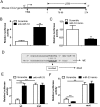MicroRNA-33 suppresses CCL2 expression in chondrocytes
- PMID: 27129293
- PMCID: PMC4859085
- DOI: 10.1042/BSR20160068
MicroRNA-33 suppresses CCL2 expression in chondrocytes
Abstract
CCL2-mediated macrophage infiltration in articular tissues plays a pivotal role in the development of the osteoarthritis (OA). miRNAs regulate the onset and progression of diseases via controlling the expression of a series of genes. How the CCL2 gene was regulated by miRNAs was still not fully elucidated. In the present study, we demonstrated that the binding sites of miR-33 in the 3'UTR of CCL2 gene were conserved in human, mouse and rat species. By performing gain- or loss-of-function studies, we verified that miR-33 suppressed CCL2 expression in the mRNA and protein levels. We also found that miR-33 suppressed the CCL2 levels in the supernatant of cultured primary mouse chondrocytes. With reporter gene assay, we demonstrated that miR-33 targeted at AAUGCA in the 3'UTR of CCL2 gene. In transwell migration assays, we demonstrated that the conditional medium (CM) from miR-33 deficient chondrocytes potentiated the monocyte chemotaxis in a CCL2 dependent manner. Finally, we demonstrated that the level of miR-33 was decreased, whereas the CCL2 level was increased in the articular cartilage from the OA patients compared with the control group. In summary, we identified miR-33 as a novel suppressor of CCL2 in chondrocytes. The miR-33/CCL2 axis in chondrocytes regulates monocyte chemotaxis, providing a potential mechanism of macrophage infiltration in OA.
Keywords: CCL2; chemotaxis; microRNA-124 (miR-124); microRNA-33 (miR-33); osteoarthritis; reporter gene.
© 2016 The Author(s).
Figures





Similar articles
-
Mechanical and IL-1β Responsive miR-365 Contributes to Osteoarthritis Development by Targeting Histone Deacetylase 4.Int J Mol Sci. 2016 Mar 23;17(4):436. doi: 10.3390/ijms17040436. Int J Mol Sci. 2016. PMID: 27023516 Free PMC article.
-
MiR-26a and miR-26b mediate osteoarthritis progression by targeting FUT4 via NF-κB signaling pathway.Int J Biochem Cell Biol. 2018 Jan;94:79-88. doi: 10.1016/j.biocel.2017.12.003. Epub 2017 Dec 5. Int J Biochem Cell Biol. 2018. PMID: 29208566
-
Down-regulation of microRNA-216b inhibits IL-1β-induced chondrocyte injury by up-regulation of Smad3.Biosci Rep. 2017 Apr 28;37(2):BSR20160588. doi: 10.1042/BSR20160588. Print 2017 Apr 30. Biosci Rep. 2017. PMID: 28356485 Free PMC article.
-
The Role of MicroRNAs in the Pathophysiology of Osteoarthritis.Int J Mol Sci. 2024 Jun 8;25(12):6352. doi: 10.3390/ijms25126352. Int J Mol Sci. 2024. PMID: 38928059 Free PMC article. Review.
-
MicroRNA in osteoarthritis: physiopathology, diagnosis and therapeutic challenge.Br Med Bull. 2019 Jun 19;130(1):137-147. doi: 10.1093/bmb/ldz015. Br Med Bull. 2019. PMID: 31066454
Cited by
-
Basal and IL-1β enhanced chondrocyte chemotactic activity on monocytes are co-dependent on both IKKα and IKKβ NF-κB activating kinases.Sci Rep. 2021 Nov 4;11(1):21697. doi: 10.1038/s41598-021-01063-2. Sci Rep. 2021. PMID: 34737366 Free PMC article.
-
Effect of Er Miao San on peritoneal macrophage polarisation through the miRNA-33/NLRP3 signalling pathway in a rat model of adjuvant arthritis.Pharm Biol. 2022 Dec;60(1):846-853. doi: 10.1080/13880209.2022.2066700. Pharm Biol. 2022. PMID: 35608068 Free PMC article.
-
Knockdown of hsa_circ_0134111 alleviates the symptom of osteoarthritis via sponging microRNA-224-5p.Cell Cycle. 2021 Jun;20(11):1052-1066. doi: 10.1080/15384101.2021.1919838. Epub 2021 May 4. Cell Cycle. 2021. PMID: 33945396 Free PMC article.
-
Intravenous injection of autologous bone marrow-derived mesenchymal stem cells on the gene expression and plasma level of CCL5 in refractory rheumatoid arthritis.J Res Med Sci. 2020 Dec 30;25:111. doi: 10.4103/jrms.JRMS_308_20. eCollection 2020. J Res Med Sci. 2020. PMID: 33912221 Free PMC article.
-
The Involvement of MicroRNAs in Osteoarthritis and Recent Developments: A Narrative Review.Mediterr J Rheumatol. 2018 Jun 29;29(2):67-79. doi: 10.31138/mjr.29.2.67. eCollection 2018 Jun. Mediterr J Rheumatol. 2018. PMID: 32185303 Free PMC article. Review.
References
-
- Kunisch E., Kinne R.W., Alsalameh R.J., Alsalameh S. Pro-inflammatory IL-1beta and/or TNF-alpha up-regulate matrix metalloproteases-1 and -3 mRNA in chondrocyte subpopulations potentially pathogenic in osteoarthritis: in situ hybridization studies on a single cell level. Int. J. Rheum. Dis. doi:10.1111/1756-185X.12431. 2014 - PubMed
MeSH terms
Substances
LinkOut - more resources
Full Text Sources
Other Literature Sources
Medical

